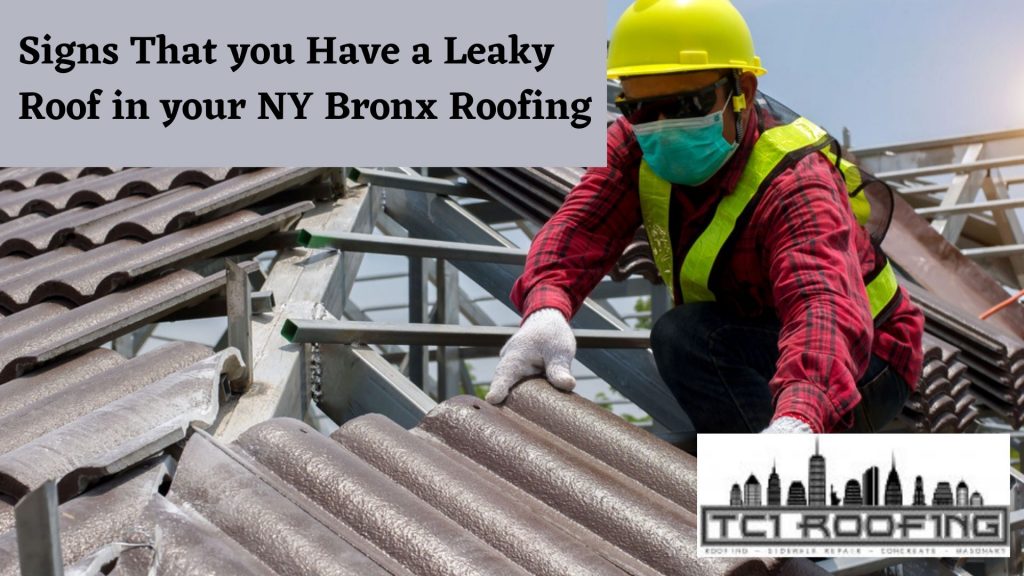It is best to be aware of the signs that you have a leaky roof in your NY Bronx roofing as a roofing contractor. A leaky roof can lead to serious problems for your home, and it is best to take care of them promptly before they become an issue. Leaky roofs are often easy to spot because there will be visible water damage on various parts of the exterior walls and damaged roof. If you notice any discoloration or wet spots on the outside wall, chances are you have a leaky roof and you need to have the best roof repair.
The Obvious Signs
Despite the housing market’s ups and downs over the last few decades, most economists believe that owning a home is the essential way to accumulate wealth. Homeownership comes with many advantages, including the chance to develop equity and take advantage of tax reductions. However, it also comes with new duties. For example, instead of phoning the landlord, the homeowner must fix the aging air conditioner or repair the leaky roof on their own. Must have roof repairs and roof replacement with standard roofing materials from a properly licensed roofing contractor before deciding to have a new roof.
If you’re collecting rainwater in a bucket in the kitchen, your roof has been leaking for quite some time. Your attic, ceiling, and rafters may be harmed as a result of the leak. In addition, mold and mildew can form. As a result, you are posing a health risk.
While water flowing from the ceiling is a telltale symptom of a leaking roof due to heavy rain and cold weather, you should not wait until then to get help. Instead, look for early warning indicators.
Discoloration
Water will be absorbed into your ceiling before it starts leaking. Your roof will become discolored after absorbing a large amount of water. Take a flashlight and study your ceiling thoroughly to see if there are any wet spots. Water damage will resemble coffee stains in appearance.
If you’re looking for wet spots, don’t forget to look inside closets and in the basement. Always inspect the ceiling above tubs or appliances, as pipes often lead up to the roof and may cause extensive damage and you will need roof repair.
Damage to Wood and Drywall
If the leaking persists, it may spread from the ceiling to the drywall in your home. Your walls’ structural integrity may be jeopardized as a result of this you will need roof leaks repair. Look for signs of warping at the seams between your walls and ceiling. You might even notice areas that are starting to crumble or dust. In severe circumstances, entire drywall portions may even collapse.
Additionally, you may observe damage to wood beams that contribute to the construction of your home. Wooden beams, studs, and joists can decay as a result of water damage. The wood will need to be replaced if the damage continues.
Mold and Mildew
Water can become trapped in limited places if it leaks into your home. Humidity is created as the water level rises. Mold and mildew begin to grow in this atmosphere. Mold can create respiratory difficulties for you and your family if it grows in your house. Look for black or dark patches that resemble a stain to check for mold. Also, make sure there is no mold in damp areas like the attic or basement.
Electrical Problems
If a leak is left unattended for a long time, it might cause harm to your home’s electrical system. Water may affect the wires themselves or your electrical circuit box, depending on where the leak is located.
The majority of your home’s cables are comprised of copper, which erodes over time. If the damage is not repaired, wires may break or short out. In addition, if the dripping water damages your home’s breaker box, the entire electrical system can be thrown off.
Storm Damage
If you have any cause to suppose your roof has been damaged, you should inspect it for a leak. Storm damage might result in missiles causing dents in your roof or strong winds ripping shingles off. If you live in a region where a severe storm has hit, you should inspect your roof to ensure it is not damaged.
Look at Your Shingles
It’s critical to pay attention to the shingles whenever you inspect your roof. Asphalt shingles are the most widespread in the United States. These are intended to keep rainwater off your roof and protect it from wind damage. However, exposure to the outdoors will cause your shingles to deteriorate over time.
The shingles along the roof’s edge are frequently the first to be damaged. Keep an eye out for curling, chipped, or damaged shingles. In addition, a part of your roof may be missing multiple shingles in some circumstances.
Pipe Boots
The majority of houses have pipes that extend to the roof. If the lines pass through the top, they can cause leaks and other issues.
Most pipes have protective coverings called pipe boots to protect them from the elements. These are typically constructed of rubber or lead and have a 7-10 year lifespan. If one of these boots becomes damaged, you’ll need to repair it to avoid a leaky roof.
Check for Puddles
Water builds on your roof before it begins to drip from your ceiling. Look for puddles of water on your roof when you climb up there. This could indicate that your roof isn’t correctly diverting rainwater into gutters and away from the structure. If you notice puddles on your top, you should seek professional assistance to determine the source of the problem. Water will not pour down the chimney and into your property because brick chimneys are coated with metal “flashing.”
Caulking or tarring a chimney does not substitute for adequate flashing. Ensure that the seals are flush with the chimney by inspecting them. If they aren’t, they’ll have to be resealed to avoid leakage.

